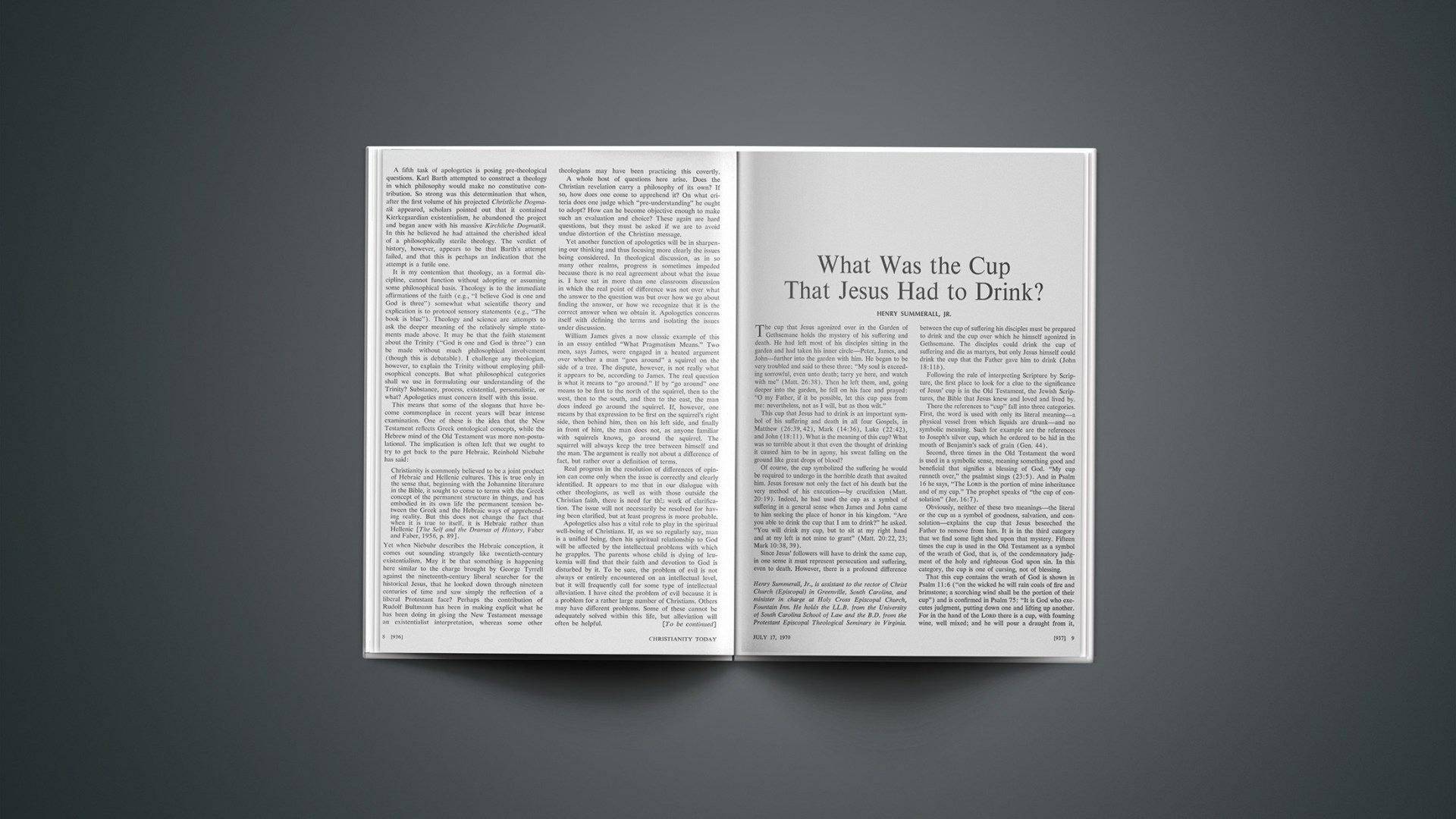The cup that Jesus agonized over in the Garden of Gethsemane holds the mystery of his suffering and death. He had left most of his disciples sitting in the garden and had taken his inner circle—Peter, James, and John—further into the garden with him. He began to be very troubled and said to these three: “My soul is exceeding sorrowful, even unto death; tarry ye here, and watch with me” (Matt. 26:38). Then he left them, and, going deeper into the garden, he fell on his face and prayed: “O my Father, if it be possible, let this cup pass from me: nevertheless, not as I will, but as thou wilt.”
This cup that Jesus had to drink is an important symbol of his suffering and death in all four Gospels, in Matthew (26:39, 42), Mark (14:36); Luke (22:42), and John (18:11). What is the meaning of this cup? What was so terrible about it that even the thought of drinking it caused him to be in agony, his sweat falling on the ground like great drops of blood?
Of course, the cup symbolized the suffering he would be required to undergo in the horrible death that awaited him. Jesus foresaw not only the fact of his death but the very method of his execution—by crucifixion (Matt. 20:19). Indeed, he had used the cup as a symbol of suffering in a general sense when James and John came to him seeking the place of honor in his kingdom. “Are you able to drink the cup that I am to drink?” he asked. “You will drink my cup, but to sit at my right hand and at my left is not mine to grant” (Matt. 20:22, 23; Mark 10:38, 39).
Since Jesus’ followers will have to drink the same cup, in one sense it must represent persecution and suffering, even to death. However, there is a profound difference between the cup of suffering his disciples must be prepared to drink and the cup over which he himself agonized in Gethsemane. The disciples could drink the cup of suffering and die as martyrs, but only Jesus himself could drink the cup that the Father gave him to drink (John 18:11b).
Following the rule of interpreting Scripture by Scripture, the first place to look for a clue to the significance of Jesus’ cup is in the Old Testament, the Jewish Scriptures, the Bible that Jesus knew and loved and lived by.
There the references to “cup” fall into three categories. First, the word is used with only its literal meaning—a physical vessel from which liquids are drunk—and no symbolic meaning. Such for example are the references to Joseph’s silver cup, which he ordered to be hid in the mouth of Benjamin’s sack of grain (Gen. 44).
Second, three times in the Old Testament the word is used in a symbolic sense, meaning something good and beneficial that signifies a blessing of God. “My cup runneth over,” the psalmist sings (23:5). And in Psalm 16 he says, “The LORD is the portion of mine inheritance and of my cup.” The prophet speaks of “the cup of consolation” (Jer. 16:7).
Obviously, neither of these two meanings—the literal or the cup as a symbol of goodness, salvation, and consolation—explains the cup that Jesus beseeched the Father to remove from him. It is in the third category that we find some light shed upon that mystery. Fifteen times the cup is used in the Old Testament as a symbol of the wrath of God, that is, of the condemnatory judgment of the holy and righteous God upon sin. In this category, the cup is one of cursing, not of blessing.
That this cup contains the wrath of God is shown in Psalm 11:6 (“on the wicked he will rain coals of fire and brimstone; a scorching wind shall be the portion of their cup”) and is confirmed in Psalm 75: “It is God who executes judgment, putting down one and lifting up another. For in the hand of the LORD there is a cup, with foaming wine, well mixed; and he will pour a draught from it, and all the wicked of the earth shall drain it down to the dregs” (vv. 7, 8).
In the prophetic writings, the meaning of the cup as a symbol of God’s wrath is made absolutely clear. Isaiah says: “Rouse yourself, rouse yourself, stand up, O Jerusalem, you who have drunk at the hand of the LORD the cup of his wrath, who have drunk to the dregs the bowl of staggering” (51:17, RSV). Then after God’s judgment has been executed against his people, Isaiah says: “Thus says your Lord, the LORD, your God who pleads the cause of his people: ‘Behold, I have taken from your hand the cup of staggering; the bowl of my wrath you shall drink no more’ ” (51:22).
It is in the prophecy of Jeremiah against Judah (Jeremiah 25) that the cup becomes the most striking and terrifying symbol of God’s wrathful judgment upon sin and evil. Jeremiah preached this powerful sermon to the people of Judah and Jerusalem in the year 605 B.C., the first year of Nebuchadrezzar, king of Babylon, after Nebuchadrezzar had defeated the forces of Egypt under Pharoah Neco at the decisive battle of Charchemish. Jeremiah begins his sermon by reminding his people that they have persisted in rejecting the word of the Lord and have provoked him to anger because of their idolatry and unbelief. The prophet then transmits to his people the word of the Lord, that because of Judah’s disobedience, the Lord would send Nebuchadrezzar, king of Babylon, as the Lord’s instrument (notice “my servant,” verse 9) to destroy Judah utterly, so that the land would lie a ruin and waste. Then after seventy years, the Lord’s punishment would fall upon Babylon for its iniquity.
At this point in his sermon, perhaps Jeremiah actually took a cup of wine and dramatized his sermon by insisting that members of his congregation representing various nations actually drink from it: “Thus the LORD, the God of Israel, said to me: ‘Take from my hand this cup of the wine of wrath, and make all the nations to whom I send you drink it. They shall drink and stagger and be crazed because of the sword which I am sending among them’ ” (25:15, 16).
So Jeremiah took the cup from the Lord’s hand and made all the nations to whom the Lord sent him drink it, beginning with Jerusalem and the cities of Judah, its kings and princes; then Egypt; then the Philistines on the west of Judah; then Edom, Moab, and Ammon on the east of Judah; then the kings to the southeast of Judah; then last of all, the king of Babylon himself. The Lord ordered Jeremiah: “Then you shall say to them, ‘Thus says the LORD of hosts, the God of Israel: Drink, be drunk and vomit, fall and rise no more, because of the sword which I am sending among you.’ And if they refuse to accept the cup from your hand to drink, then you shall say to them, ‘Thus says the LORD of hosts: You must drink! For behold, I begin to work evil at the city which is called by my name, and shall you go unpunished? You shall not go unpunished, for I am summoning a sword against all the inhabitants of the earth, says the LORD of hosts’ ” (27–29).
Behind Jesus’ agony over the cup in Gethsemane lies this terrible scene from Jeremiah where the Lord God forces all the nations and inhabitants of the earth to drink the wine of his wrath upon their sin.
Not only in Isaiah and Jeremiah but also in the prophecy of Ezekiel, the cup is a symbol of God’s wrathful and righteous judgment upon sin. This is found in chapter 23, the allegory of the two harlot sisters Oholah (representing Samaria, the Northern Kingdom of Israel) and Oholibah (representing Jerusalem, the Southern Kingdom of Judah), who were warned they would drink “a cup of horror and desolation” (vv. 31–34).
Thus, to the three major prophets of the Exile, the cup of the Lord was a terrible and horrible symbol of God’s wrath and judgment upon sin. Other references to the cup with this meaning are Jeremiah 49:12; Jeremiah 51:7; Lamentations 4:21; Habakkuk 2:16, and Zechariah 12:2. And this interpretation of the cup from the Lord’s hand—that it represented God’s holy wrath upon sin—begins to open the depths of the dark mystery of Jesus’ cup in Gethsemane. No wonder Jesus, the sinless One, shrank from the cup and was “exceedingly sorrowful even unto death.”
It is significant that the New Testament records that Jesus actually did drink vinegar or sour wine while he hung on the cross. When he was offered wine mixed with the sedative gall or myrrh, he refused it (Matt. 27:34; Mark 15:23). But near the end of his agony, when he cried out, “My God, my God, why hast thou forsaken me?” (Matt. 27:46; Mark 15:34), one of the bystanders ran and filled a sponge with vinegar, and put it upon a reed or spear, and gave it to him to drink. The Greek word used, potizo, carries the meaning that he actually drank the vinegar, though the English translation does not make this clear. St. John makes a special point of recording that it was immediately after Jesus had received the vinegar that he said, “It is finished,” and bowed his head and gave up his spirit (John 19:28–30; see also Matt. 27:48–50; Mark 15:37). He had drunk the cup that the Father had given him, and he had accomplished what he had been sent to earth to do, and so he cried out, “It is finished.”
The Old Testament references to “cup” make it clear that the cup Jesus had to drink, the cup the Father gave to him, contained symbolically the wrath of God. This interpretation is further supported by the references to “cup” in the Book of Revelation (14:9, 10; 16:19).
Many American Christians are more imbued with a sentimental idea of “love” than with scriptural teaching and are offended by the suggestion that there is an element of wrath in God’s love. Yet we cannot be true to the Scriptures and neglect their clear teaching about the wrath of God. Although it is certainly true that “God is love” (1 John 4:8), Scripture makes it abundantly clear that God’s love is holy love that blazes out in wrath and anger at human sin. Even St. John, the theologian of God’s love, writes: “He who believes in the Son has eternal life; he who does not obey the Son shall not see life, but the wrath of God rests upon him” (3:36).
In short, we cannot have a biblical doctrine of the atonement won by Jesus Christ on the cross without taking into account the wrath of God. Perhaps the reason we have difficulty with this idea is that we really do not take sin as seriously as Scripture shows us God does.
We can picture the metaphor of the cup in this way: Because each one of us is guilty of both original and actual sin, we deserve to be forced to drink the cup of God’s wrath; however, Jesus the sinless One, true man and true God, received the cup of wrath from the hand of God the Father himself and drank it all, even the bitter dregs, for us, on our behalf. Then, having emptied the cup of God’s wrath by taking it within himself, Jesus, the risen Lord, filled the cup with his own blood. He now holds out to us the cup, which is no longer a cup of cursing but by his sacrificial death has been transformed into a cup of blessing, a cup that contains his life. As St. Paul wrote: “The cup of blessing which we bless, is it not a participation in the blood of Christ?” (1 Cor. 10:16).
Thus the metaphor of the cup holds out to us the same atonement that we find elsewhere in the New Testament. It is in line with St. Paul’s teaching that God made him who knew no sin (that is, Jesus Christ) to be sin for us, that we might be made the righteousness of God in him (2 Cor. 5:21), and that “Christ redeemed us from the curse of the law, having become a curse for us” (Gal. 3:13).
In the presence of the One who had such love toward us that he suffered once for all the bitter pains of hell for us, on our behalf, in our place, what can we do but say with the psalmist:
What shall I render unto the Lord
for all his benefits toward me?
I will take the cup of salvation,
and call upon the name of the Lord.










